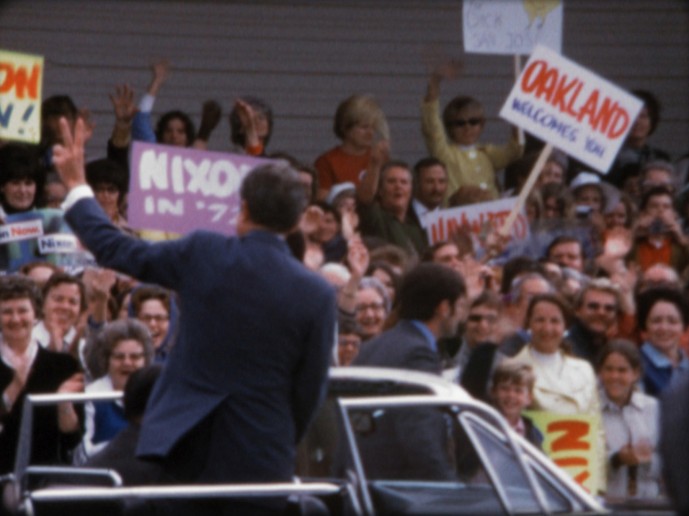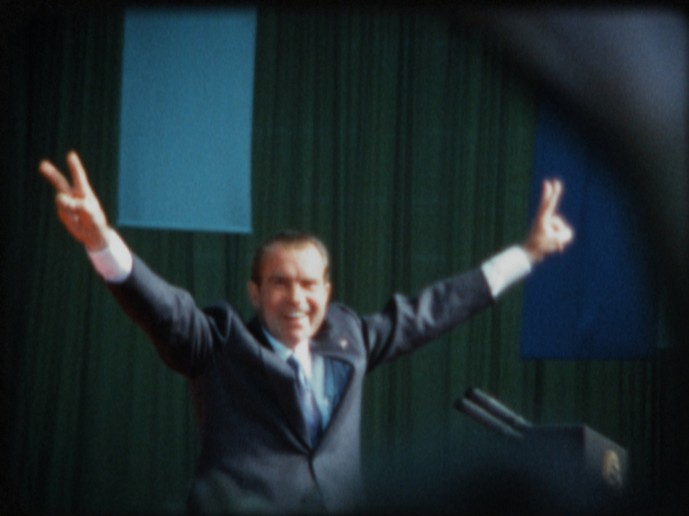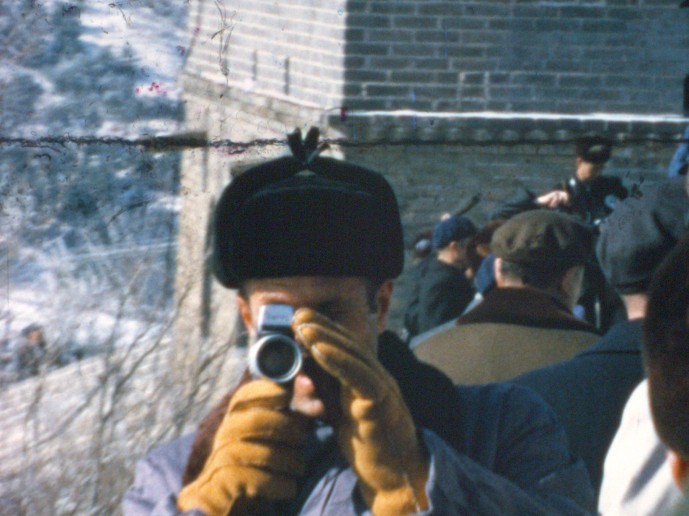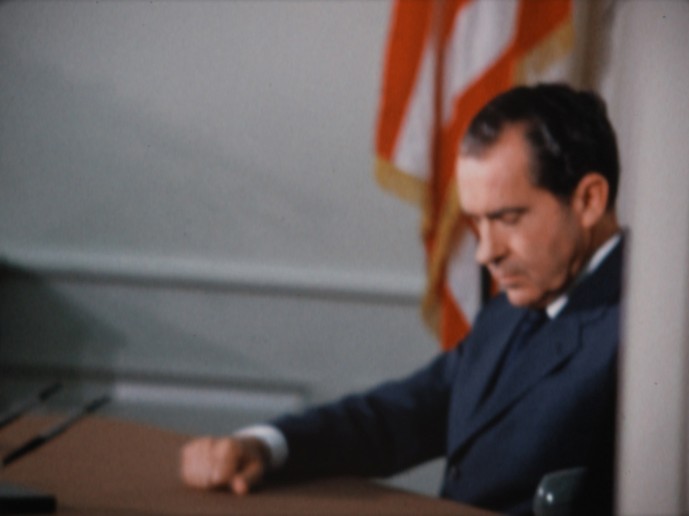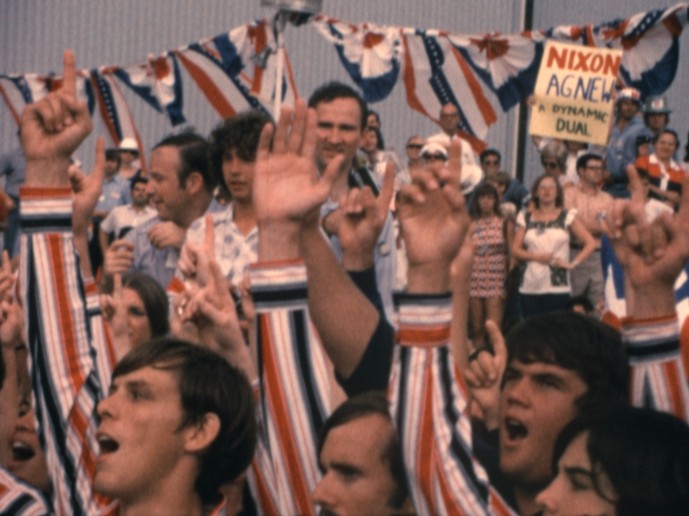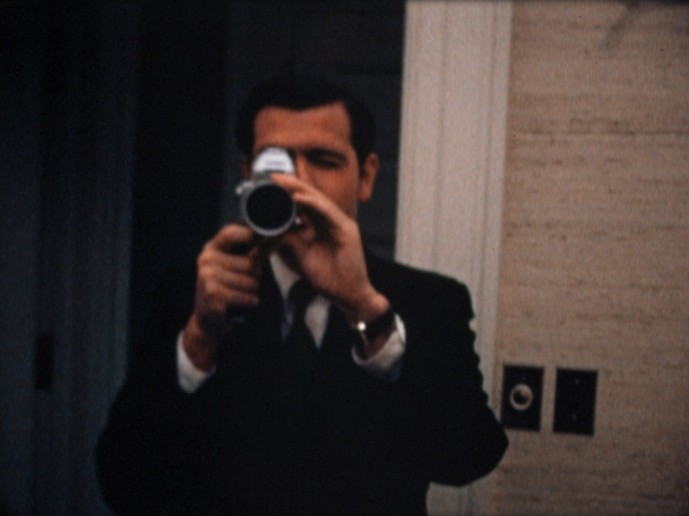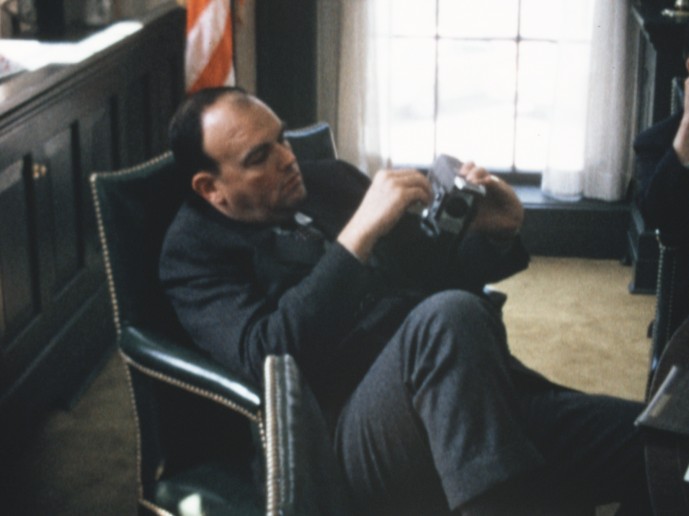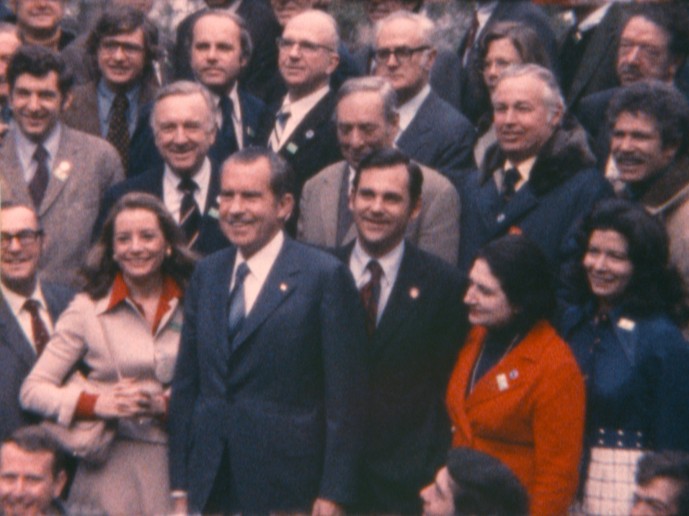Click here to print
Our Nixon is Probably Not Your Nixon
posted November 17, 2013
Two documentary-film makers complicate matters with home movies his henchmen left behind
n
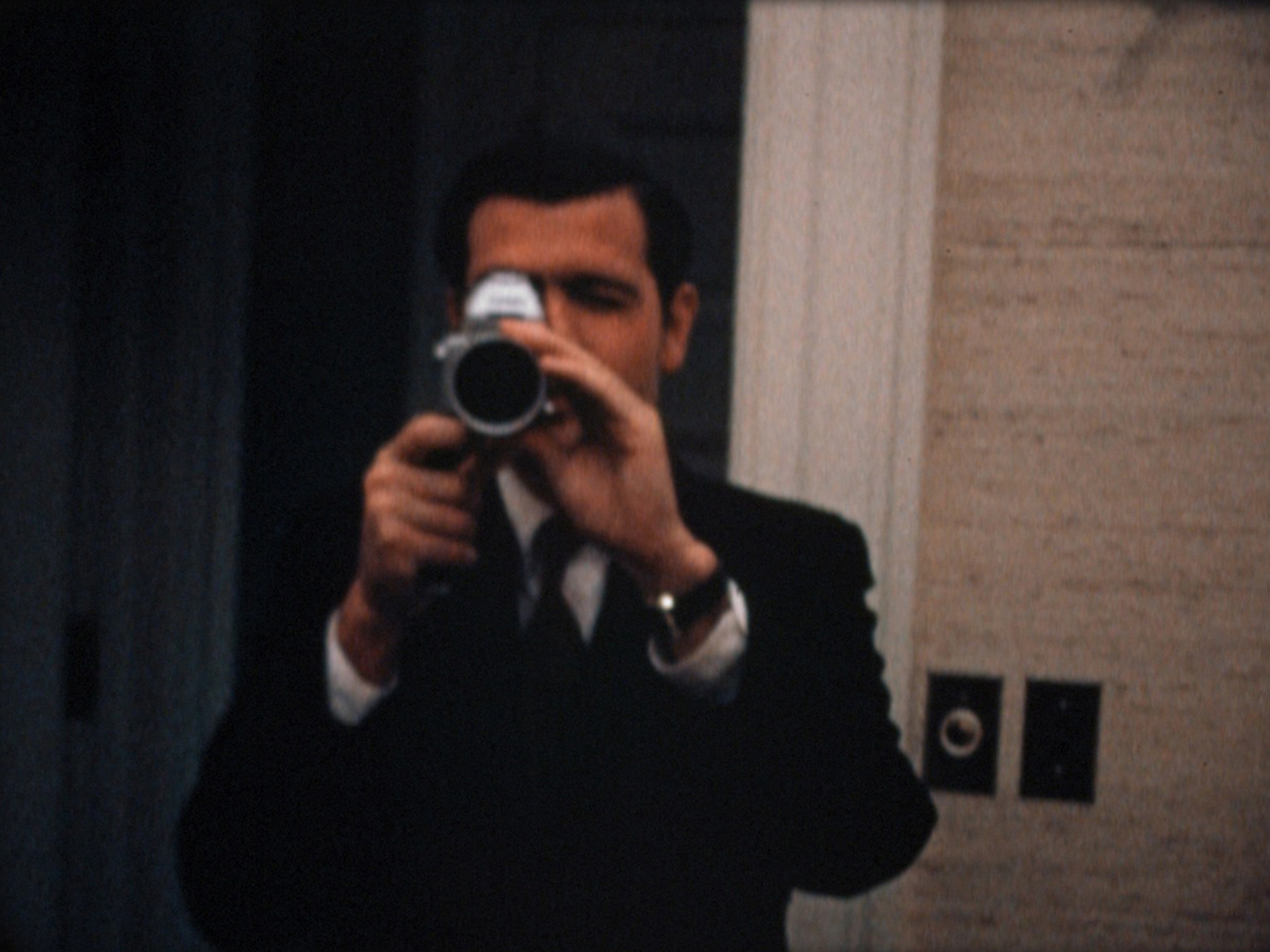
Over time, the Richard Nixon we think we know has been much shaped by film, television, and photography.
Those, and the smirch of infamy.
Countless biographies and tomes have set the political-science terrain. It’s a wonder that Penny Lane and Brian L. Frye have managed to find anything to add.
Yet, they have. They have dug up some obscure archival film of a kind suitably odd given its connections to the rivetingly weird 37th President. The two filmmakers have shaped the material into a compelling, curious, and inevitably contentious documentary film, Our Nixon (Dipper Films).
Throughout its 84 minutes, Lane (editor) and Frye (producer) ably appeal to the millions of Americans who continue to find Nixon a decent-enough backer of reform policies and accomplishments, or a rogue and knave, or a political and moral cipher…
Few viewers under 35 will know much about Nixon; as much as he might float about in the zeitgeist, it’s not clear he was knowable, to anyone. Only some aspects of his personality were projected, or distorted, on the way to voters’ consideration: Generally to his detriment, he was among the first generation of the thoroughly mediated public official. As a result, he came to most Americans as images and sounds that then shaped his legacy:
- The White House audio tapes that, like a wishful schoolboy, he clumsily sought to conceal.
- The farewell wave from the door of the plane that hauled him back to the Coast.
- The “Checkers speech” – an hallucinatory high point in the psycho-political moving image. (Nixon delivered it while facing allegations of illegally accepting gifts while Dwight D. Eisenhower’s 1952 vice-presidential running mate; see esp. 7:24-10:06.)
With Nixon, perhaps with any US president, the bizarre seems never to end. Frye and Lane have generated a fresh take on him with a cache of startling films: some 26 hours – 450 reels — of black-and-white images captured on Super 8 cameras by three Nixon White House insiders. Dwight Chapin, Nixon’s appointments secretary; H.R. “Bob” Haldeman, his chief of staff; and John Ehrlichman, head of Nixon’s domestic council (and, in a few instances, Haldeman’s assistant Larry Higby) shot the film essentially as home movies of the White House. They record its daily life, its prominent visitors, its buzz of political operations and machinations.

From arriving at the White House in 1969, Haldeman, Erhlichman, and Chapin were wherever their President needed them to be. For their own satisfaction, they filmed more than 500 reels by 1973, as Nixon’s crisis deepened (he resigned in August 1974). They had the best seats to the raging protests of the anti-war era, to White House reactions to the Apollo moon landing, to visits by world leaders including Rumania’s crackpot Communist head of state Nicolae Ceausescu and Chou En-lai, the first Premier of the People’s Republic of China.
They were there for the less lofty occasions, too, such as hours aboard Air Force One, Easter-egg hunts on the White House lawn, and Tricia Nixon’s 1971 White House wedding. Erhlichman’s footage of hummingbirds illustrates his passion for birding.
Thanks to the Nixon aides, Lane and Frye have been able to work with some of the darnedest footage – they describe much of it in terms that befit the home-movie ethos: goofy, lighthearted, funny, genuine. We see, for example, that the Nixon White House apparently was a chummy place. Responding to their boss’s anxious, unctuous energy, the aides appear not only terribly young, but idealistic to the point of gloating. They strategize, kibitz, plot, gossip.
The home movies provide glimpses into what was at first a triumphal realm, but then devolved to a crumbling redoubt where Nixon slipped into paranoia. Of course, even before Our Nixon begins, we know that the merry crew would soon veer off into the cynical insanity of Watergate, and go down in the annals of American political iniquity – in the case of the three aides, via prison.
Digging Up the Super 8
The footage owes its circulation beyond government archives to Lane and Frye. They learned of it a decade earlier, from a friend, Bill Brand, a film maker, archivist, and restoration expert. As they put it, Brand had told them that the home-movie collection was “sort of just sitting, forgotten but in the public domain,” in a vault of the U.S. National Archives and Records Administration.
Most startling is that the aides’ films had sat unused since FBI agents confiscated them 40 years ago, at the time of the prosecution of the criminal White House shenanigans. It was, in fact, Ehrlichman’s copies of the films that the FBI seized, when he resigned in April 1973. The three aides had made their amateur films with Super 8 film stock provided and then processed by the U.S. Navy Photographic Film Center, and had then shared copies movies among themselves.
n
Images courtesy of Dipper Films.
n
That collection and other seized items of Nixon evidence became U.S. Government (which is to say, public) property in 1974 upon passage of the Presidential Recordings and Materials Preservation Act.
Lane and Frye say they knew as soon as they heard of the films that they could use them to generate an extraordinary document of one of the nation’s most disillusioning public melodramas. But gaining access to them proved no easy task. Federal archivists told them that, in the interests of preservation, they could not view the original film, but only DVD transfers, for which they would have to pay. They did so, but discovered that the rolls of film were in poor shape, already a common problem with Super 8 film. But because the Nixon home movies were “so astonishing,” say Lane and Frye, they figured it would serve their needs.
The filmmakers encountered various twists and turns of film formats, accessibility, and reparation on the film’s web site. The long and short of it is that they eventually had to have the film transferred to a format they could use in their documentary. Frye explains: “What made it not available to the public for many years was that it was never preserved, and then once it was preserved, and then once it was preserved it wasn’t initially made into a format that viewed by researchers and the public. The film was initially preserved to 16mm internegative, in 1999-2001.” After that was done, still “there was no budget to make video transfers; it was purely a preservation projection. So there were some reference copies that were done basically by videotaping the screen of a Steenbeck, but you can imagine what that looked alike.”
The material sat in storage for years at the Nixon Presidential Library & Museum which “allowed us to transfer from the 16mm internegative on the condition that we did a transfer of everything and as a function of us going that, the material became available to the public.” That process involved working with second- and third-generation copies of the original films.
After they did that, and thought they were close to finishing their project, the complications increased in 2011. They learned that the Nixon Foundation, which originally ran the Nixon Presidential Library & Museum, had received Haldeman’s collection of the aides’ films, and that contained Super 8 original prints rather than copies. Says Lane: “We knew it was going to be night and day in terms of quality. We knew what Super 8 should look like, but we’d been working from what looked like bad photocopies of Super 8.”
Adds Frye: “When we learned about the Super 8 originals, even though we paid a substantial amount of money for the initial transfers, we knew we had to invest in doing the video transfers all over again.”
The Nixon Library could not afford to make standard 16mm internegative copies, so Lane and Frye offered to pay for archival-quality “4K” (state of the art) scans. That made the added expense of “tens of thousands of dollars” theirs. “It was a crazy thing to do,” admits Lane.
They hired Jeff Kreines, inventor of the then-experimental Kinetta film scanner, to perform the work. As Frye and Lane explain in publicity material, “he scanned every frame of the entire collection at a resolution four times that of HD video and delivered them to us as digital Cineform files saved at native 18 fps.”
Getting It Done, Again
When the Haldeman collection turned up, did Lane and Frye pause, and consider not taking on the potentially nightmarish rush to incorporate it? That, says Lane, was never going to happen: “That’s how it is to be a filmmaker, isn’t it? If you ever knew what it would take to make a film, you would say ‘No.’ For starters, “it was a kind of coup that changed everything,” she adds.
Rather, the filmmakers’ challenge was to find a way to prevent a delay of years in matching up footage from the Haldeman films (often in locations and order that differed from the Ehrlichman copies, and with only about 85% equivalence between the two collections) and then subbing it into their own film’s final cut. “It was of drastically higher quality,” says Frye. “It was extremely exciting from a technological standpoint because in the past people have not bothered, essentially, to do video transfers of Super 8 at extremely high resolution. And it really does make a huge difference to the experience of the film, because that really small image demands the highest possible resolution on the grain. You can get away with a slightly lower resolution on a larger format where the grain isn’t as apparent. But with a Super 8, any softness in the grain… you feel it almost immediately. So the sharpness of these new transfers really does make a huge difference in conveying the real experience of watching Super 8 films at home, properly projected. They really pop when you see the film projected large.”
But it complicated things: “We literally had already finished the film,” says Lane. She and Frye had had to work with poor-quality copies of copies of the original Super 8 film, but it was “so astonishingly interesting” that she and Frye thought it worth using. “It was kind of a hard decision to have to reassemble the entire film, every single edit, by hand. There was no time-code relationship. It wasn’t a typical off-line edit, on-line edit. This as hundreds of hours of having to go back and find shots we had used from one collection of film and see if we could find the same shots in the other collection. It was actually an insane thing to do but it resulted in a film that is a gazillion times better.”
That, she adds, suited both her and Frye’s needs as filmmakers and the Nixon Library’s needs in terms of experimenting with an affordable method of digital film preservation – in this case, Jeff Kreines’s Kinetta scanner is not making video transfers; they’re scans, but a frame by frame scan of such high resolution that he’s making the pitch that this is the future of film preservation. It’s a step closer to something someone could actually use, as opposed to something like a 16mm internegative.”
And, adds Frye, “technical speaking, the image quality is probably better because it’s a direct image of the film itself, whereas an optical print is going to be a film-to-film transfer, so you’re always going to be introducing an additional generation in there. I also think, from an archival standpoint, there’s something quite peculiar about the idea of prioritizing preservation of film on film, when the original is already a film. Unless there’s been some degradation to the original, the new copy doesn’t really add anything, preservation-wise or longevity-wise to what you already have, right?” Certainly in relation to Super 8, for says.
For the financial wherewithal to pay for such needs, Lane and Frye turned to various sources, including the Kickstarter online “crowd-funding” platform. “Interest really exploded, there,” says Frye. “That generated a lot of at least guarded intrigue among a lot of people.” They raised $25,000 there, and then another $200,000 from granting organizations and private investors. “Our budget kept getting bigger,” she says, “but we were lucky to get a number of grants, and to have a couple of executive producers and investors come on. As far as I can tell, it was a blessed series of events.” Probably only due to the work and effort they committed to, over two years, “we never went that long before another source of funding came in. I’ve seen other people’s films grind to a halt for years.”
The Nixon insiders’ home-movie film comprises 60 percent of Our Nixon. To contextualize it, Frye and Lane include selections from news broadcasts, interviews, oral histories, and other sources. Intent on a creating a nuanced sense of the Nixon White House, which they say they found “shocking both in its casual criminality and its heartbreaking naiveté.” To evoke that sense of shock, they included where possible portions of the additional source material that had rarely if ever been used. They drew strategically from, for example, the infamous White House tapes that Nixon recorded only later to seek to conceal incriminating portions.
Lane and Frye say that one effect they sought to achieve was to place the home-movie and other footage in juxtapositions that would generate questions about how history is made. They imply that any history of the Nixon White House must take account of both the bizarre actions of Nixon and his operatives and their already-confused times.
A Departure for Lane and Frye
After festival showings, Our Nixon emerged prominently as one the documentaries in CNN’s series CNN Films, which began in the spring of 2013. It is now in distribution around the country through Cinedigm. It should have legs, because fascination with Nixon shows no sign of waning.
For the two filmmakers, Our Nixon is something of a departure, as their prior experience has been in more overtly experimental film. In 2012, Filmmaker Magazine included both Lane and Frye in its “25 New Faces of Independent Film.” Lane was the 2009 Iowa City Documentary Film Festival’s “Most Badass!”
Penny Lane has directed and produced award-winning documentary and essay films since 2002. Those have screened at many festivals. Among her work is NUTS!, an animated documentary about an eccentric snake-oil salesman who built an empire on goat testicles and a million-watt radio station. Her The Rules of Evidence is a feature-length essay film about the history, theory, and practice of using film as legal evidence. Her 2005 film, The Abortion Diaries, has become widely used in efforts to de-stigmatize abortion.
Brian L. Frye’s experimental film making has used archival and amateur images to explore relationships among history, society, and cinema. Some of his films are in the permanent collection of The Whitney Museum, in New York city. He also teaches law relating to art at the University of Kentucky.
Our Nixon has attracted positive reviews from screenings at several film festivals and other events. It is a “triumph of editing”(Variety) that “stands out for its total commitment to primary sources”(Filmmaker Magazine). It is “a disarmingly jaunty peek into a notoriously dark era” (The Hollywood Reporter) and “a closer look at Nixon’s circle of trust than we’ve ever seen before” (IndieWire). It “injects humorous complexity into an era of secrecy” (Time Out New York). Far from simple, it makes the Nixon era “richer, murkier, and all the more complex,” (Film Comment). For the New Yorker’s Richard Brody, “as the footage unspools, I want to hold the moment and look closely at the faces, the expressions, and the material details.”
Some reviewers have voiced reservations. In the New York Times, Alessandra Stanley is measured: “It’s not entirely clear what the film’s vivid pastiche of home movies and archival material amounts to. It’s an engrossing but somewhat aimless and impressionistic ramble through the Nixon presidency and tumult of the 1970s. At times it leans too heavily on artistic license.”
On rogerebert.com, TV critic and filmmaker Matt Zoller Seitz writes that even though the film is “not as strikingly original as advance publicity suggested.”
But Seitz then returns to the abiding positive reception of Our Nixon: “You can’t be entirely sure why Lane and her editors are fixating on certain details of Nixon’s character and career and ignoring others, but this is ultimately more compelling than irritating.”
Our Nixon is most remarkable, Seitz says, for “its willingness to paint its key players as people, not villains or types,” which “makes them seem more comprehensible and real — like people we might know, but with power.”
Indeed, Lane and Frye say that part of the appeal of the found film was that it provides a better sense than regular historic documents of the personality of these bit players in presidential history. The filmmaker-aides “could stand in for a whole other America that has been largely ignored by popular history: the great majority of square Americans who supported Nixon.”
Here, their take is frankly odd: “We’d always imagined,” they write, that “everyone in that era was dropping out and burning their draft cards. The home movies give a glimpse of a different America, one that is still very much alive today.”
Nixon did win the presidency!

Contentious Among Nixon’s Diehard Devotees
To comment on Richard Milhous Nixon is to court contention. Frye and Lane have copped some of that. In August 2013 Ben Stein, now an economist, financial adviser, and finance journalist, but in 1973-4 a Nixon speechwriter, scoffed in an op-ed article on The Daily Beast that ”Our Nixon is “simply ‘news from nowhere,’ revelations of events that either did not happen the way they were presented or, more important, happened but were of such trivial importance that they reveal nothing meaningful and new about the Nixon administration.”
Stein insists that Our Nixon is “false” because the home-movie footage was always available. Lane and Frye swiftly dispense with that objection in a reply on The Daily Beast. They make Stein’s challenge look extraordinarily shoddily researched – especially for a recipient of a Malcolm Forbes Award for Excellence in Financial Journalism.
Archivists, in particular, will find compelling Lane and Frye’s explanation of what makes archival film “rare,” “unavailable,” or simply so budget busting that it is effectively out of reach.
It is also telling to note the aspect of the film that Stein does approve: its presentation of the three earnest aides: “I can attest,” he writes, “to the truthfulness of these images of clean-cut young men and women going purposefully about their lives. Those parts are superb.”
A Nixon-apologist campaign has dragged on ever since its hero was deposed. One of its battlegrounds has been the Nixon Library where loyalists long resisted displaying any hint of their man’s betrayal of his office. The case continues to be made that Nixon and his operatives committed no wrong, or perhaps a peccadillo or two; prisons are full of criminals who make such claims for themselves.
Stein writes: “Our Nixon started out as history, but in its extremely unbalanced negative portrait of a man who did the ultimate that any human can do — make peace among men — the film deteriorated into the usual propaganda of the Nixon haters”[emphasis added; sorry, missed that].
Similarly militantly defensive of Nixon is – hardly surprising – the Nixon Foundation, itself. A private group, it set up the Library in 1990 in Yorba Linda, California. It did not have Nixon’s presidential records because the National Archives and Records Administration feared releasing them to apologists intent on hagiography. (In 2006, after a long legal battle, the National Archives took control of the Nixon Library, which became the country’s 12th federally run presidential archive.) Turns out, the Nixon Foundation didn’t need the records to canonize St. Richard. It quickly mounted an exhibition that suggested that the Watergate break-in as a Democratic conspiracy to overturn the 1972 election.
Little changes: In response to Our Nixon, the Nixon Foundation published a “review” by no less dependable a witness than Dwight Chapin. He tells us that ‘Our Nixon is Not My Nixon.” Fancy.
No Particular Political Agenda
Chapin, the sole living member of the home-movie crew, reiterates Stein’s shoddy claims about the films’ availability. And adds on behalf of himself and his Super 8 colleagues: “The film, in my opinion, barely explores our years together, and doesn’t come even close to portraying or presenting ‘our’ Nixon,” who remains “the man I gladly and proudly served.”
Self-deceived then, unrepentant now? Frye and Lane presumably would not object to Stein and Chapin’s prompting that question, 40 begrudging years after their indictments.
Lane and Frye claim their film enacts no particular political agenda, and that they instead wished to provoke discussion across political and generational lines of a still-relevant force in American civic life. They justly contend that the home-movie footage begs for inclusion in the telling of the Nixon saga. The “astonishing footage,” they say in their press materials, “led us to care about and identify with these men, which was surprising given what we knew about their misconduct. We realized that we knew little about them. Who were they? What made them so loyal to Nixon?”
Is Our Nixon designed to restore its subjects to some sort of honorable standing? Says Frye: “We both were familiar in a general sense with the history of the Nixon Administration but didn’t have any investment in the Nixon Administration or its rehabilitation, but also didn’t have any investment in its vilification. We were just interested in who these people were, how this film came to be, and what we could learn that would be an interesting story to tell about the Nixon Administration and these people.”
Lane and Frye say they have no intention of rationalizing or forgiving Nixon. Certainly, they say, he emerged as all too human from the “White House Tapes,” the Watergate hearings, and much else. Those, Frye and Lane suggest, proved “funny, mystifying, creepy, and sad,” but they have no qualms about enhancing understanding of him – of “humanizing” him. Frye chuckles: “We saw this as more of a human-interest story, in some sense, than as an agenda-driven film.” Adds Lane: “It really doesn’t make him look good. It makes him look petty, and bumbling, sometimes drunk. It’s hard for anyone to make the argument that it makes him look better.”
Viewing the White House of Nixon’s day in the way provided by aides’ Super 8 films, and knowing that they were sucked into the limelight, or the harsh light of the justice system, says Frye, “there’s a sort of Rosencrantz and Guildenstern element to this.”
Printed from Moving Image Archive News: http://www.movingimagearchivenews.org
URL to article: http://www.movingimagearchivenews.org/our-nixon-is-probably-not-your-nixon/
Click here to print
